Harvester ants, although not a significant danger to humans, can still cause a disturbance in your backyard if left uncontrolled. A colony of harvester ants can grow up to 12,000 workers in five years, and with a lifespan of 15-20 years, they are indeed resilient pests.
So, how to get rid of harvester ants? The best way to completely eliminate the harvester ants in and around your home is by using ant baits. You can also using boiling water, baking soda and diatomaceous earth.
To know more about how to get rid of harvester ants, you can continue reading.
What Are Harvester Ants?
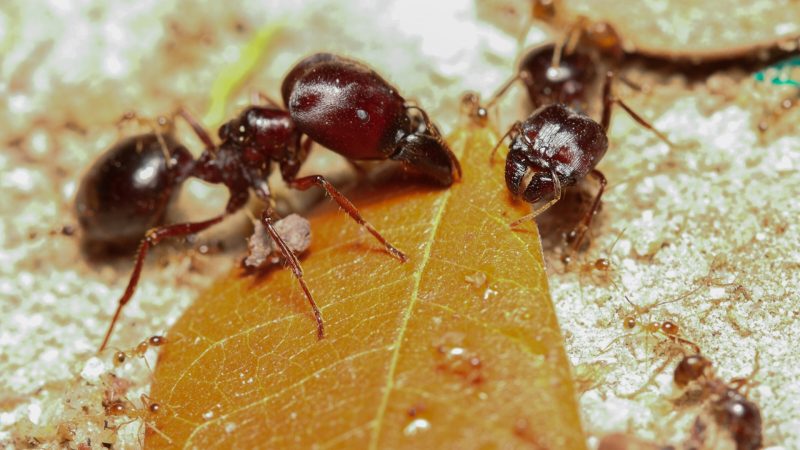
Harvester ants are so-named due to their habit of collecting seeds and mushrooms. They dig deep tunnels and create chambers within the soil which helps with aeration, benefiting nearby plants. Their foraging and colony building also mixes the upper and deep layers of soil, as well as organic refuse, into the soil.
Unfortunately, their harvesting of seeds can damage grazing land by reducing the vegetation. The ants’ workers are about ¼ to ½ inch long and have red and dark brown bodies. A queen is chosen as a larva and is fed special food to help her grow and prepare for a life of reproducing. Once mature, she digs a tunnel and starts producing eggs.
The larva hatch and go through several instar stages before joining the worker population, where they take care of younger siblings, forage for food, and expand the colony. The colony can survive as long as the queen is alive, as she is the only one that can lay eggs to grow the population.
Harvester ants tend to sting only when their nest is disturbed, and their sting can be quite painful. However, due to their seclusion and conspicuous nests, it is not easy to disturb them, meaning they rarely sting humans.
What Do Harvester Ants Eat?
Harvester ants have a specialized diet of collecting and consuming seeds. They take the seeds back to their colony for consumption, and any seed that contains starch is suitable for their diet. These ants have square-shaped heads with large mandibles that are well-suited for chewing seeds.
In addition to seeds, harvester ants also consume dead insects. This diet provides the ants with all the necessary nutrients they require, including water, which they obtain from the food they eat.
Related: What Do Ants Eat? | Fascinating Insights into Ant Diets and Behavior
Are Harvester Ants Dangerous?
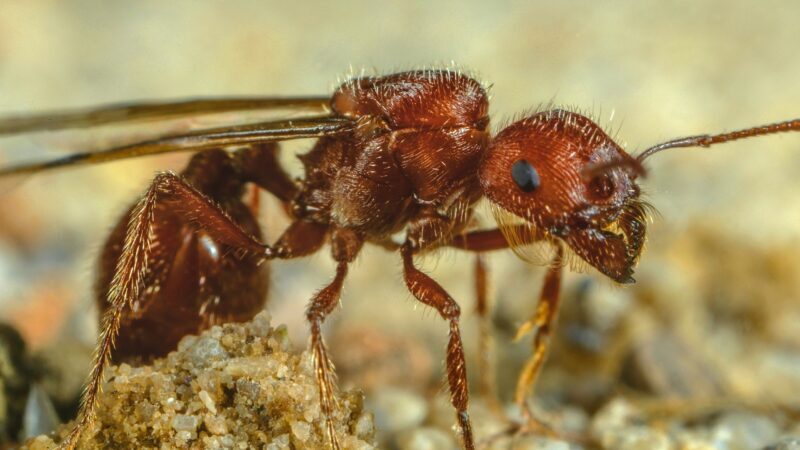
Harvester ants are not typically considered dangerous to humans because they do not actively seek to sting people. They will only attack if their habitat is disturbed, which is rare since they usually colonize open fields and their colonies are easily visible.
However, their stings can be extremely painful, with some people comparing them to bee stings. The pain can last for several hours or even days. In most cases, there won’t be any allergic reactions, and cleaning the wound with warm soapy water is usually sufficient.
Applying calamine lotion can also help soothe the wound. However, some individuals may have an allergic reaction to the stings and require medical attention.
Difference Between Harvester Ants and Fire Ants
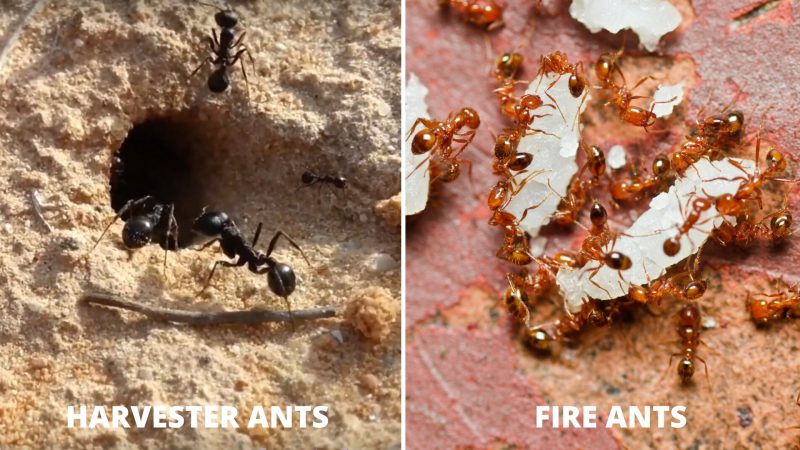
Harvester ants and fire ants are often confused for one another because of their physical similarities and their similar method of stinging. However, there are some significant differences between the two ant species.
The main difference is in their diet. Harvester ants primarily feed on seeds, while fire ants will eat almost anything, including animals, vegetables, and sweet substances.
Another difference is their nests:
- Harvester ant nests are characterized by a single opening in a bare patch of land, often surrounded by vegetation except for the portion left bare by foraging harvester ants. Foraging paths can also be seen leading to the bare patch.
- Fire ant nests are not as easy to spot as they are characterized by a soft mound of soil protruding from a random section of your yard. These mounds can be located under trees, in grassy patches, and other areas.
How to Get Rid of Harvester Ants?
Nest Toxicants
Nest toxicants are the most effective way to eliminate harvester ants from your backyard, but professional exterminators can only perform this method. If you call a specialist to eliminate these ants from your garden, nest toxicants will likely be their go-to method. This is a surefire way to kill the entire colony at once.
Ant Baits
Alternatively, you can use ant baits to eliminate harvester ants. Since these ants collect seeds, you can place ant baits in their paths, and they will carry the bait back to the colony. After some time, the harvester ants and their queen will consume the bait. Once the queen ingests the poison, she will be dead in a few days, which is the beginning of the end for the colony.
To ensure the ant baits reach the queen, it is best to place several baits along the ants’ foraging trails. Below are some recommended ant baits for eliminating harvester ants.
- ATTRACTS & KILLS: TERRO liquid ant baits indoor effectively...
- KILLS THE ANTS YOU DON'T SEE: TERRO ant bait is designed to share...
- FAST-ACTING: Noticeable ant activity reduction within days as...
- READY TO USE: Simply place ant baits indoors with no setup...
- VERSATILE HOME PLACEMENT: TERRO ant traps are ideal for use along...
- One 8 count package of Raid Ant Killer Baits protects against...
- Raid Ant Killer works for up to 3 months to help control ants in...
- This pest killer comes in convenient Raid Ant Traps where ants...
- Raid Ant Killer is ideal for use throughout your home, including...
- Try other Raid bug spray and insect killer products for all of...
- ATTRACTS & KILLS: Effectively targets and eliminates common...
- KILLS THE ANTS YOU DON'T SEE: Terro ant bait is designed to share...
- FAST-ACTING: Noticeable ant activity reduction within days as...
- READY TO USE: Simply place ant baits indoors with no setup...
- VERSATILE HOME PLACEMENT: Ideal for use as terro ant traps along...
Harvester ant colonies can pose challenges for this process, as their deep tunnels may require multiple baits to reach the queen. However, if this method does not appeal to you, rest assured that there are other effective methods mentioned in the following sections of this article. In fact, we’ve outlined several alternative strategies that may be just as effective.
How to Get Rid of Harvester Ants Naturally?
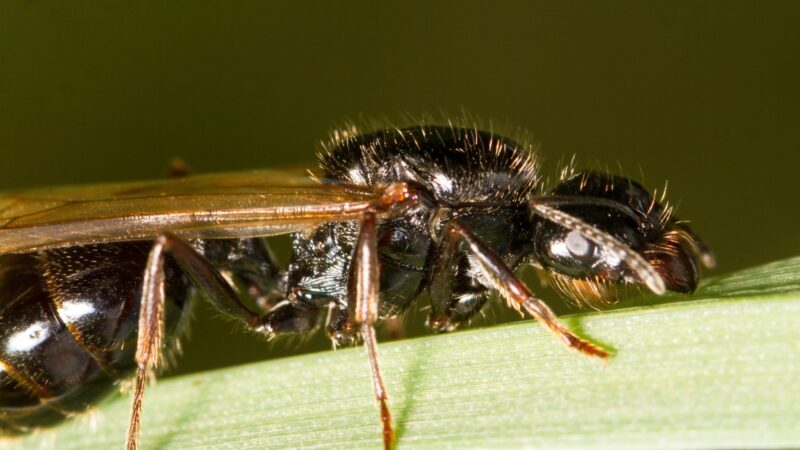
Boiling Water – This can be an effective method if done properly. Simply fill a container with hot water and carry it to the location of the ant colony. Pour the water into the opening of the harvester ant settlement. Be careful when handling hot water to avoid burning yourself. Pouring hot water into the ground should not negatively affect the vegetation since established harvester ant colonies have already destroyed the vegetation around their settlement.
Baking Soda – Apply baking soda to the base of your plants as it is poisonous to ants and will deter them from touching your plants. While this method might not completely eliminate the ants from your yard, it is an environmentally friendly way of dealing with them.
Diatomaceous Earth – Sprinkle diatomaceous earth into the harvester ant nest mound. This substance dehydrates every ant that comes into contact with it. Repeat this process until you are certain that the ant population is gradually diminishing in size.
Related: How to Get Rid of Ants Naturally: A Complete Guide
How to Prevent Harvester Ants From Invading Your House?
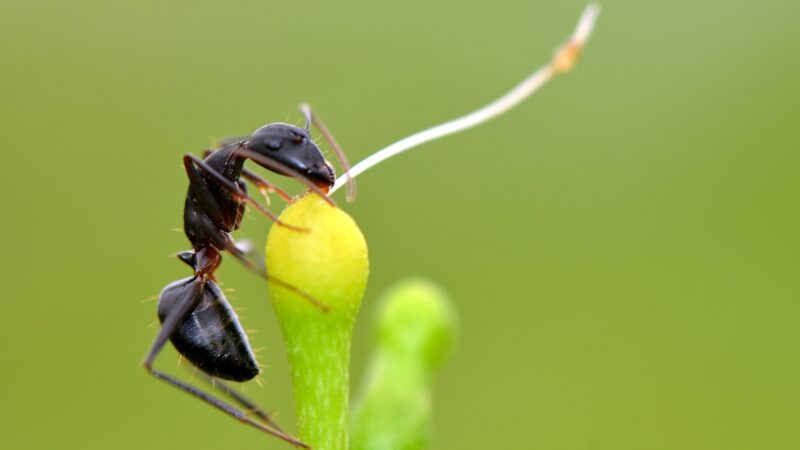
Harvester ants typically prefer to live in open fields where they have access to their main food source, which is seeds. If you find them inside your house, it is important to seal any windows, doors, or cracks they may have used to enter your home. However, if you have harvester ants in your house, it is likely that you also have them in your yard.
To prevent future infestations, it is best to contact a specialist who can recommend the best chemicals to apply to protect your plants and your family. Additionally, you can take steps to eliminate possible food sources in and around your home, such as picking up fallen fruits or nuts and keeping food stored in airtight containers.
It is also essential to keep your yard free of debris, as this can provide hiding places for ants. Regularly checking your yard for signs of an ant infestation and promptly addressing any issues can help prevent future problems.
Related: Top 19 Foods That Attract Ants | Irresistible Foods for Ants!
List of Sources
Davis J., Management of the Red Harvester Ant Pogonomyrmex barbatus, Texas Parks and Wildlife Department
Pinter-Wollman, N., Bala, A., Merrell, A., Queirolo, J., Stumpe, M. C., Holmes, S., & Gordon, D. M. (2013), Harvester ants use interactions to regulate forager activation and availability, Animal behaviour, Stanford University, University of California
Tschinkel W. R. (2013), Florida harvester ant nest architecture, nest relocation and soil carbon dioxide gradients, Department of Biological Science, Florida State University
Red Harvester Ants, Texas A&M AgriLife Extension Service
Ants Management Guidelines, Agriculture and Natural Resources, University of California
- How to Get Rid of Copperheads | Practical Guide - August 27, 2023
- How to Get Rid of Corn Snakes | What Makes Them Aggressive? - August 27, 2023
- How to Get Rid of Alligators | Safety Measures and Removal Methods - July 16, 2023



